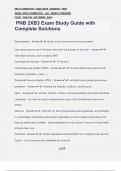EMILLYCHARLOTTE 2024/2025 ACADEMIC YAER
©2024 EMILLYCHARLOTTE. ALL RIGHTS RESERVED
FIRST PUBLISH SEPTEMBER 2024
PNB 2XB3 Exam Study Guide with
Complete Solutions
Neuroscience - Answer✔✔-study of the neurons and nervous systems
how many neurons are in the brain and what is the power of the brain - Answer✔✔-
100 billion neurons, and it is about 20W
how large are neurons - Answer✔✔-10 microns
Central Nervous System (CNS) - Answer✔✔-all the parts within bone (spinal cord,
thalamus, brainstem, cortex...)
Peripheral Nervous System (PNS) - Answer✔✔-not within bone (peripheral nerves)
brainstem - Answer✔✔-includes the medulla, midbrain, and the pons
spine - Answer✔✔-cervical, thoracic, lumbar, and sacral sections with each vertebrae
numbered - can then be used to classify which parts of the skin&nerves come from
where
Neurons - Answer✔✔-cells with an axon that produce action potentials, are enclosed
in a lipid bilayer membrane and contain organelles, but have unique morphology and
they are electrically excitable - action potentials are not unique to neurons (muscle cells
produce them too)
Dendrites - Answer✔✔-receive signals/neurotransmitters from neighbouring neurons
(input) - not all neurons have dendrites but most do
1/57
,EMILLYCHARLOTTE 2024/2025 ACADEMIC YAER
©2024 EMILLYCHARLOTTE. ALL RIGHTS RESERVED
FIRST PUBLISH SEPTEMBER 2024
Axons - Answer✔✔-send the signals to other neurons (output) - axons will often
branch into many pathways, but only one will come off of the cell body
Action potentials - Answer✔✔-rapid increases and then decreases of voltage along
the action potential (caused by rapid depolarization to the threshold)
Astrocytes (CNS) - Answer✔✔-glial cells that maintain ionic environment
oligodendrocites and schwann cells - Answer✔✔-glial cell that forms myelin around
neurons
Microglia - Answer✔✔-glial cells that scavenge cellular debris
Nissl Stain - Answer✔✔-piece of neural tissue is treated with a Nissl Stain solution
that will dye the cell bodies of neurons - there are areas of varying density called cell
layers (usually 6)
Nissl stain showed (Nissl) - Answer✔✔-Nissl used basic dyes (cresyl violet, thionine)
to stain the ER (RNA in the nucelus) to reveal cell bodies
Nissl stain showed (Broadmann) - Answer✔✔-found that different areas of the
cerebral cortex had distinct cytoarchitectonic (density of neurons) appearances (52
cortical areas, now called broadmann's areas) - evolutionailly older cortex will have
fewer layers
cerebrospinal fluid (CSF) - Answer✔✔-aqueous saline solution surrounding neurons
that contains sodium, potassium, chloride, and other ions in solution
neuronal membrane - Answer✔✔-impermeable to the movement of ions, but ions can
cross by either ion transporters and ion channels
2/57
,EMILLYCHARLOTTE 2024/2025 ACADEMIC YAER
©2024 EMILLYCHARLOTTE. ALL RIGHTS RESERVED
FIRST PUBLISH SEPTEMBER 2024
Ion transporters - Answer✔✔-active transporters (enzymes) that use energy to
actively move selected ions against concentration gradients to create ion concentration
gradients
Ion channels - Answer✔✔-do not use energy and they allow ions to diffuse down a
concentration gradient and are selectively permeable to only certain ions
sodium potassium pump - Answer✔✔-enzyme that transports 3 sodium to the
outside, and it transports 2 potassium to the inside using the hydrolysis of ATP - creates
more sodium outside and more potassium inside and creates a concentration gradient
neuronal membrane permeability (at rest) - Answer✔✔-primarily permeable to
potassium because the membrane contains leak potassium ion channels, allowing
potassium to diffuse out of the cell, which makes the inside of the cell negative when
potassium flows out of the cell
equalibrium potential - Answer✔✔-The potential at which the net flow of an ion would
be zero due to electrostatic and diffusion forces being equal and opposite - still
movement, but no net movement
Diffusion of potassium - Answer✔✔-when potassium diffuses out of the cell down its
concentration gradient (outside of the cell)
Electrostatic force of potassium - Answer✔✔-as potassium diffuses out, the inside
becomes progressively more negative, and the positive potassium is attracted to the
inside
3/57
, EMILLYCHARLOTTE 2024/2025 ACADEMIC YAER
©2024 EMILLYCHARLOTTE. ALL RIGHTS RESERVED
FIRST PUBLISH SEPTEMBER 2024
Nernst equation - Answer✔✔-allows us to calculate the equilibrium potential (Ex) for
a particular ion (X) using the electric charge, the outside concentration and the inside
concentration
equilibrium potentials for potassium and sodium - Answer✔✔-EK is around -84, ENa
is around +67
Membrane potential at rest is most similar to - Answer✔✔-neuron is primarily
permeable to potassium, so the resting potential is close to EK, but is not the same as
the neuron is still somewhat permeable to other ions
neuraxis - Answer✔✔-axis of the nervous system - in humans, the neuraxis curves at
the brain
Neuraxis before curving - Answer✔✔-dorsal is behind, ventral is infront, caudal is
down, and rostral is up
Neuraxis after curving - Answer✔✔-dorsal is up, ventral is down, caudal is back, and
rostral is front
General axis - Answer✔✔-superior is above, inferior is below, anterior is infront of,
and posterior is behind
Midline, ipsilateral and contrelateral - Answer✔✔-line separating left and right of the
entire nervous system - ipsilateral means the same side of something and contralateral
means the opposite side of something
Decussate, medial and lateral - Answer✔✔-to cross over to the other side of the
brain, medial is near the midline and lateral is far from the midline
4/57




